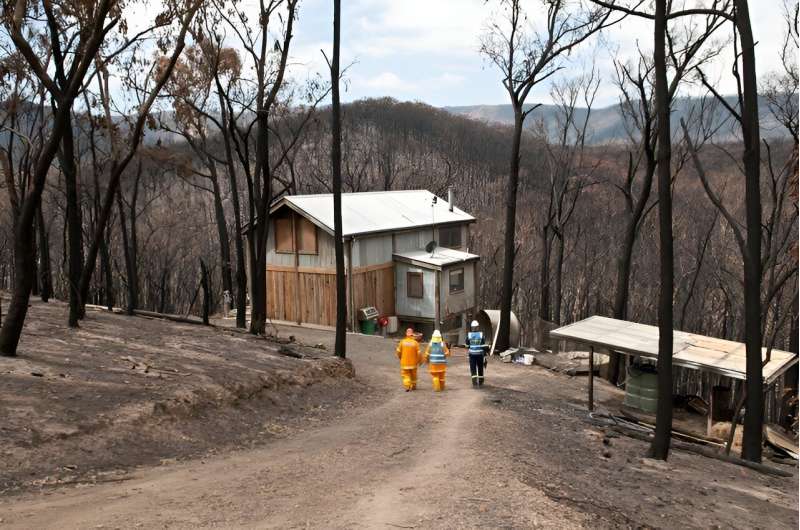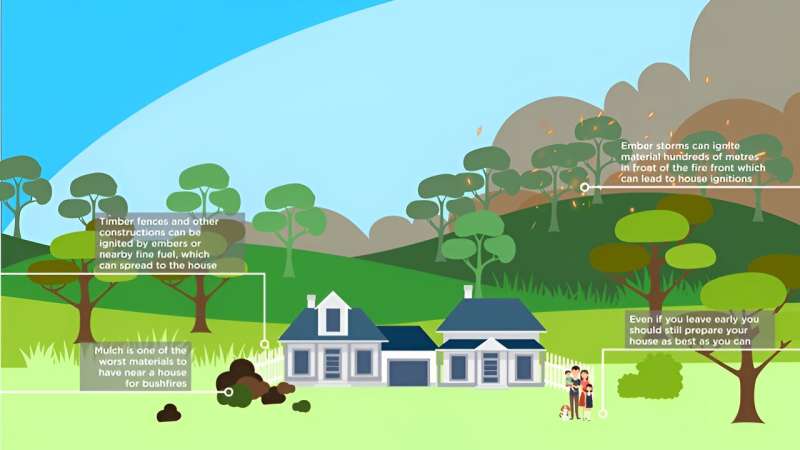This article has been reviewed according to Science X's editorial process and policies. Editors have highlighted the following attributes while ensuring the content's credibility:
fact-checked
trusted source
proofread
Expert: When it comes to being prepared for bushfires, safety starts in your own backyard

With hotter and drier conditions expected this summer, we can expect an increase in high fire danger days. So, it's good to be prepared. No property can ever be completely safe from bushfire, but there are some ways to address some of the weak links a bushfire may exploit. One of CSIRO's bushfire experts, Justin Leonard, has decades of experience in understanding how we can manage bushfire risk to life and infrastructure. He provides these tips to help prepare your home.
Your house can be at risk even if it isn't directly exposed to bushfire
At least 85% of houses are destroyed without experiencing direct exposure to flames or significant radiation from a bushfire front. For these houses, ember attack and low-level surface fire either directly ignites or enters the house. Or fire ignites nearby combustible elements that then threaten the house. So even if your house doesn't directly border bushland, it is still important you do everything you can to safeguard it.
Clear your garden of excess mulch
Vegetation-based mulch is one of the worst materials to have near your house in a bushfire. It is very difficult to extinguish once ignited and can easily transport low-level surface fire to nearby buildings and other combustibles. Fire has destroyed houses well after the bushfire has passed when mulch, previously thought to have been extinguished, has reignited. Radiant heat from mulch beds next to houses can be enough to break windows and ignite timbers.
Trees can actually help mitigate fire risk
Trees mitigate wind and embers and can reduce the rate the landscape surrounding your home dries out. Removal of trees promotes the growth of the previously shaded undergrowth. This can increase the rate of spread and severity of a fire. It also reduces wind protection of your house which can make it susceptible to ember attack and surface fire.

Check your yard thoroughly for hazards
These items can create a risk in your yard and around your home:
- trees, including fallen tree limbs
- gas bottles
- mats
- stored firewood
- outdoor furniture
- containers of volatile fuels like petrol, farm chemicals, paint and solvent liquids stored below gapped verandas and timber decks.
Embers or burning fine fuels such as grass can ignite timber fences, retaining wall sleepers, steps, decks, firewood, and posts, leading to the destruction of a house. CCA-pressure treated pine is particularly vulnerable.
Even if you're leaving early, you should prepare your house for fire as best you can
Bushfire fuel on a property creates a risk for neighbors—and the wider community. Reducing fuel improves the chances of a house surviving a bushfire. A fire starting in, or spreading onto, a property can destroy the house and other outbuildings.
Depending on how far you are from your neighbors, a burning building on your property can become a radiant heat source to a neighbor's house. This can lead to secondary ignitions and widespread impacts, like a domino effect. Getting your home bushfire-ready can help your community.
Remember, you can never be 100% safe from bushfire. These measures, like all other risk reduction actions, address some, but not all the weak links a bushfire may exploit. They form part of a risk management strategy that will help increase the chance of your property surviving a bushfire.
Rural fire authorities in each state provide additional tips through their websites to help residents prepare for bushfires.
CSIRO has also published a Bushfire Best Practice Guide for Building in Bushfire Prone Areas in Victoria. This Guide also shows how to improve the bushfire resilience of your home and garden.
Provided by CSIRO




















